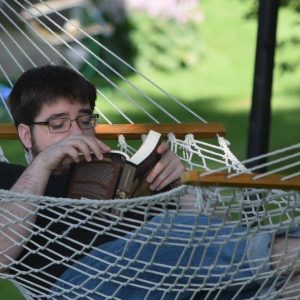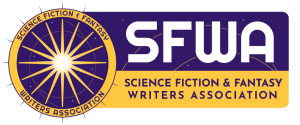by Austin Conrad
How do you move forward when stuck on telling a story? Sometimes the best way is to play your story at the gaming table. A roleplaying game’s collaborative creativity is a fun and effective method of discovery “writing” your way through writer’s block. Better yet, this can be used whether you’re writing games or fiction!
As a game writer, I’m well aware of the advantages and disadvantages of my chosen medium. Good games have compelling narratives but also leave space for player agency. Writing for such an open medium is exciting—without the restriction of a programmed computer, nearly anything can happen in a tabletop game! Yet balancing this freedom with writing a game that purchasers can play easily is quite challenging.
Playing the game over and over is how game designers strive to find that point of balance. In contrast, prose writers have much more control over their medium. The best prose is “playtested”—in a sense—by beta readers, but the medium lacks the fundamental open-ended aspect of a tabletop game. When writing fiction, I care about the reader’s emotional response, but when writing games I must consider how the “reader” might act.
This openness is also an advantage, and an advantage writers in various media can adopt while crafting their own work. However, this open-ended approach to narrative weakens plot structure when used too eagerly in other forms of writing.
Stuck and Unstuck
Playtesting material is as routine for game writing as beta readers or critique groups are for fiction writing. While writing the adventure To Hunt a God, I got stuck and stuck bad. I knew how the story began, I knew its characters, and I knew its ending. During the adventure, the players go into a forest on a quest, and then…I didn’t know. Outlining wasn’t working, and my ideas weren’t clearing up no matter how long I beat my head against them. Eventually I said, “Screw it, I’ll playtest what I’ve got.”
Turns out, that was the right answer.
Playing one-on-one with a friend, when he entered the forest, I focused on responding to his actions rather than trying to develop the story. When stumped or thrown off by one of his choices, I asked the player what he thought might happen next. Then I’d twist his ideas a little. The story we discovered was neither wholly mine nor wholly his. Like most tabletop games played at the table, the end result was a shared narrative.
The secret sauce to this experience—I realized much, much later—is that playing the game wasn’t merely “I need to break writer’s block.” It was also fun. Having fun in the collaborative process fueled our creativity and helped me discover the middle of my story.
Playing Your Writing
You don’t have to be writing a game to discovery-write through play. True “play” doesn’t even require knowing about rules or dice or game systems! At its heart, this process is about sitting down with someone and asking, “What if?” Working together with a friend or colleague feeds those social parts of our brain that encourage us to speak, interact, and problem-solve. Having fun cracks frustration’s shell and helps us think about the narrative in different ways.
I often find myself doing this with a writer friend when discussing our work. We’re both gamers, and often we’re not even aware that we’ve shifted into that frame of mind. Talks about character, setting, and plot become a call-and-response in which we’re each describing how another story element might react to a new idea. This is the heart of playing a tabletop game: vividly imagine impossible things and what they might do.
What’s less effective, however, is introducing a sticking point as a problem to your “player.” Saying “I have a problem” flicks on the at-work brain. Instead, describe your story’s situation and character, and ask a friend, “What do you think so-and-so would do?” Framing the process this way sets the expectation as imaginative and creative, rather than productive. If you want, even break out some dice! For those not familiar with tabletop games, I recommend just rolling a standard six-sided die (like in Monopoly or Yahtzee). Whoever rolls higher decides how the conflict resolves—the character in question gets what they want, or perhaps something bad happens instead!
When Not to Game
Of course, this isn’t always effective. Many fantasy publishers include something like “We don’t want the story of your Dungeons & Dragons campaign” in their submission guidelines. And with good reason! Tabletop games are awesome, but the plot of an entire campaign’s story often is disjointed and inconsistent. For every fantasy gem like Dragons of Autumn Twilight, there’s a dozen forgettable tales.
“Discovery gaming” is a helpful tool for solving specific problems. It isn’t great for developing entire plots. Playing a game requires a great deal of openness, and players are often unpredictable. This tool is handy when aimed intentionally, but not very effective as a way to write a new book from the bottom up. For example, I played To Hunt a God with a specific goal in mind: How does the forest section resolve? I had ideas for antagonists and problems that might occur along the way, but I couldn’t figure out the structure. Discovery gaming helped me find the bones of that structure. Then I returned to the keyboard to fully develop the discovered material and ensure it cohered with the rest of the adventure.
Doing the same may help you break down the block and put its puzzle pieces back together into a satisfying story.
Bio
 Austin Conrad is a full-time writer and game designer. In a prior life, he was a counselor at a residential treatment center for seven years. He is best known for his indie publications for RuneQuest. His work for other systems has been published by EN Publishing and Menagerie Press. Austin’s most recent release is “Treasures of Glorantha 2,” a compendium of magic items from an age of god-manipulating sorcerers and imperial dragons. You can learn more about Austin’s work on his website, akhelas.com.
Austin Conrad is a full-time writer and game designer. In a prior life, he was a counselor at a residential treatment center for seven years. He is best known for his indie publications for RuneQuest. His work for other systems has been published by EN Publishing and Menagerie Press. Austin’s most recent release is “Treasures of Glorantha 2,” a compendium of magic items from an age of god-manipulating sorcerers and imperial dragons. You can learn more about Austin’s work on his website, akhelas.com.
